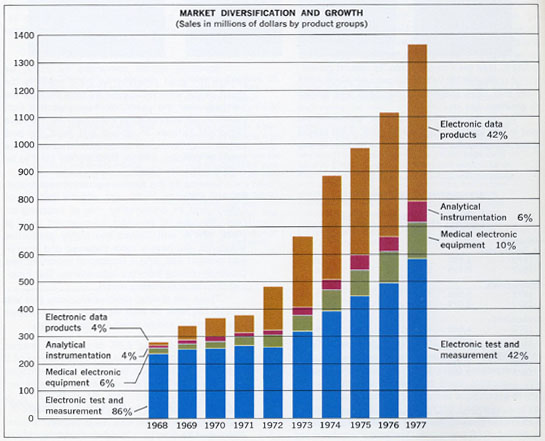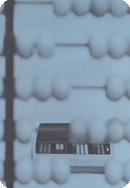


|
The Computer Transition,
Of all the developments that have influenced HP's growth over the years, none has had more impact than the company's entry into computational products in the latter part of the 1960s. Unlike all of the other "chapters", the computer history doesn't neatly fit into the 20 year period from 1960 to 1980 of this "Quick Tour." In fact, the earliest HP computer was born in 1966, and the very first desktop in 1968.
As usual, in this "Quick Tour," we will limit the described items to only those which were significant to the evolution of HP's story, and frequently important to the innovation of computing technology in general. We will distinguish between three categories, illustrated by photos from our collection showpieces:
- Desktop Calculator
- Pocket Calculator
- Interface & Application

|
Introduction by Steve Leibson
HP's success in computers and calculators: Viewed through the lens of history, HP's entry into the computer and calculator markets look like random feats that resulted in remarkable success. Bill Hewlett and Dave Packard disagreed about having HP enter into the computer market. Hewlett felt that HP was an instrumentation company and that the minicomputer market in the mid 1960s was already so overcrowded that HP's chances for market domination or even success seemed doubtful. Packard eyed the huge and growing computer market and he wanted a piece of it for HP. Eventually, Packard convinced Hewlett that HP needed a minicomputer specifically designed for instrumentation control, that such a machine would be a competitive advantage for HP, and the HP 2116A was born. HP introduced it in 1966. The HP 2116A was designed and built like any HP instrument. That meant it was rugged and could operate in many places “normal” minicomputers could not. It could be tossed into the back of a car, transported to a new location, plugged into a convenient wall socket, and expected to work just like any HP instrument when switched on. Minicomputers from other vendors at the time were hot-house flowers and needed special air-conditioned rooms to work properly. Because of their ruggedness and reliability, HP's minicomputers quickly broke out of the instrument-controller niche and became popular with business users. HP became a major player in the overall minicomputer market and the company ultimately introduced several major minicomputer families. HP also produced a highly successful line of desktop computers and it ultimately became the biggest computer company in the world. Similarly, HP “accidentally” got into the calculator business. The HP 9100A, HP's first desktop calculator, did not start as a project in Barney Oliver's fabled HP labs. Instead, it all started in the apartment of Tom Osborne, who had quit business-machine maker SCM in Berkeley, California because he knew he could design a better calculator than the design that SCM planned to manufacture. Osborne developed a prototype scientific calculator in his apartment living room. He housed it in a balsa wood case painted metallic Cadillac green and shopped it around to all of the usual corporate suspects, but no one bought. Finally, a former SCM colleague who had joined HP got Osborne an audience with the formidable Oliver, who quickly recognized the value of a desktop scientific calculator for HP's target buying audience: engineers. HP introduced the HP 9100A desktop calculator in 1968. It was a huge success and spawned many families of HP desktop calculators, computers, and workstations. The fabled HP 35 pocket scientific calculator—world's first!—followed in 1972 simply because Bill Hewlett really wanted a pocket version of the HP 9100 for himself. He ignored the low-volume sales forecasts of the market researchers and pushed his lieutenants to make it happen anyway. Such a calculator couldn't exist in 1968—semiconductor technology wasn't sufficiently advanced to permit it but by being ready with the idea when the technology advanced sufficiently to permit the idea to be realized, HP jumped into the pocket scientific calculator market early and the money simply rolled in. The HP 35 was HP's most successful product launch, ever. Apparently, Bill Hewlett wasn't the only person in the world who wanted one. Viewed through the lens of corporate management policy, HP's entries into the computer and calculator markets are not accidents at all. Behind HP's product-development and marketing policies was the bedrock concept of innovation: bring something innovative to the market, make a contribution, and the market will reward you. HP hired the brightest people it could find so that they would recognize opportunities to make a contribution whenever these opportunities walked by. So in that sense, HP's spectacularly successful entries into the computer and calculator markets are the obvious result of fundamental policies that framed how Hewlett and Packard ran their namesake company from its founding in 1939 through the 1960s and 1970s when the company broke out of instrumentation and entered these new markets.
Steve Leibson
October 2010 |
- Desktop Calculator
- Pocket Calculator
- Interface & Application

A Fast Transition,
By the end of this 20 year period (1979), HP was a 40 year old company. But in only ten short years, the computer product line had generated such a quantity of star products that HP's overall business was completely revolutionized.
A very symbolic step in Hewlett Packard's history is illustrated by the bar chart below. The graph comes from the 1977 annual report, and clearly shows that for the first time the Electronic Data Products revenue was equal to the Electronic Test and Measurement Products revenue. In 1968 the Electronic Data Product revenue was only 4%, and Electronic Test and Measurement Product revenu was 86%, representing a very fast revenue diversification indeed!
 |
| From the 1977 Annual Report Courtesy of the Hewlett Packard company |



